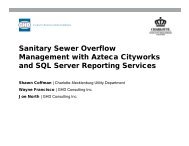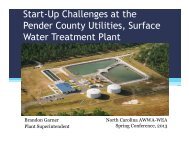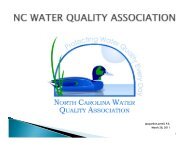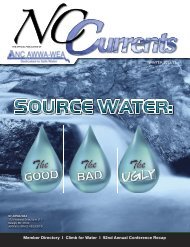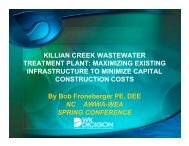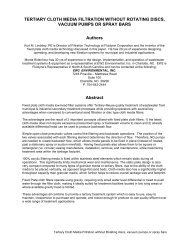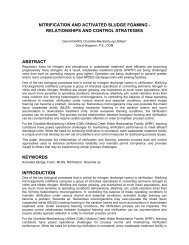HANDLING FATS, OILS & GREASES (FOG) AT WASTEWATER ...
HANDLING FATS, OILS & GREASES (FOG) AT WASTEWATER ...
HANDLING FATS, OILS & GREASES (FOG) AT WASTEWATER ...
Create successful ePaper yourself
Turn your PDF publications into a flip-book with our unique Google optimized e-Paper software.
Accepting <strong>FOG</strong> at a separate facility (either on- or offsite) versus mixing it with other receivedwastes generally would consolidate O&M in one location. However, it does require capitalexpenditure to install the facility versus using existing structures. While the extra operationalcost for heating and mixture the <strong>FOG</strong> mixture may be undesirable to budgets, this cost may beless overall when compared to increased maintenance of influent screens, grit chambers, primaryclarifiers, and scum pump stations. For the EJWWTP, the <strong>FOG</strong> addition location was chosenspecifically at the primary scum pit to minimize impact to other facilities. A poor performingscreen allowed for <strong>FOG</strong> to become entrapped within rag mats. These mats lead to an increase inthe frequency of digester cleaning. The facility has since installed a new fine screen to hopefullyreduce the cleaning frequency by means of better screening.If thickening of the <strong>FOG</strong>/scum is desired, then accepting the <strong>FOG</strong> at a separate location is idealgiven that it isolates the material that the heat benefits: the <strong>FOG</strong>. If the facility accepts <strong>FOG</strong>with other waste receiving, then the mixture of material (<strong>FOG</strong>, scum, etc) would all need to beheated and mixed. The scum could include undesirable material (floatables) that may lead toincreased maintenance on heating and mixing equipment. In addition, scum collection generallyincludes a lot of water for flushing/pumping. Heating this extra water would result in extraoperational costs unless thickening/decanting occurs prior as utilized by HRSD. If enoughexcess hydraulic capacity exists in the digestion system, then the non-thickening approachutilized by the EJWWTF could allow for minimal capital investment from the handling andreceiving facilities as a first-step approach. Once the digestion facilities reach capacity or amajor upgrade is required, then a separate handling facility could be included.CONCLUSIONSWith energy prices predicted to substantially increase in the near feature, the drive for energyrecovery will motivate innovation in the handling of <strong>FOG</strong> wastes. Therefore, it is essential tobuild experience into standards of design practice to ensure that these systems are successful. Aswith any new practice in wastewater treatment, it will be several years before such experience isbrought together into a body of knowledge and standards of practice. This paper will reduce thetime required to move the information to those needing it today.ACKNOWLEDGMENTSThe authors would like to acknowledge the following for their contributions:• David Cooley, Hampton Roads Sanitation District, VA• Susan Pekarek and Doug Nolkemper, Johnson County Wastewater, KS• Mike Englemann, Pinellas County Utilities, FL• Jim Jutras, Village of Essex Junction, VT Wastewater Treatment FacilityREFERENCESBailey, R. S. (2007) Anaerobic Digestion of Restaurant Grease Wastewater to ImproveMethane Gas Production and Electrical Power Generation Potential. Proceedingsof the 80th Annual Water Environment Federation Technical Exposition and Conference; SanDiego, California, Oct 15–17; Water Environment Federation: Alexandria, Virginia.




